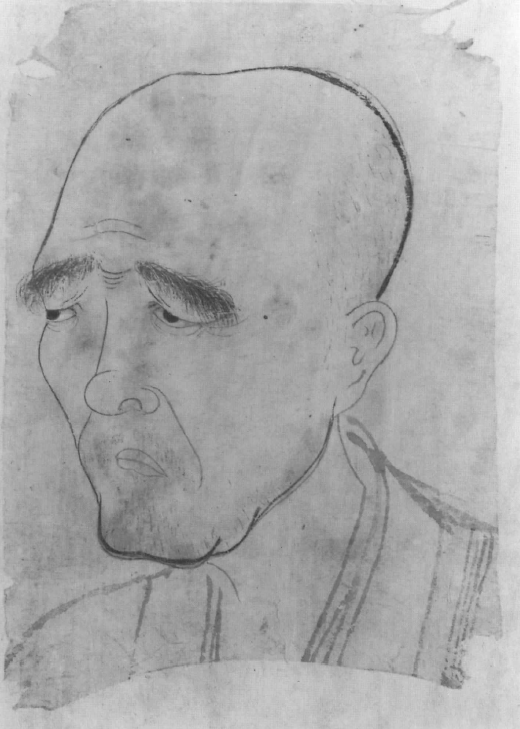ZEN MESTEREK ZEN MASTERS
« Zen főoldal
« vissza a Terebess Online nyitólapjára

白雲慧曉 Haku'un Egyō (1228-1297)
This small, most impressive portrait
sketch shows Haku'un Egyō, also known
as Inkokushi, "Master of the Hidden
Valley", the fourth abbot of Tōfukuji and
founder of Rikkyoku'an in 1294, a cloister
of Tōfukuji. Probably the sketch dates
from Haku'un Egyō's lifetime and subsequently
served as model for a number of
finished, formal portraits. Medieval portrait
painters seem to have used sketches only
for the facial features, mostly preferring
the three-quarter profile. In this magnificent
ink sketch, too, the Zen master has
turned his head slightly to the left. With an
extremely precise and pointed brush, the
anonymous painter first captured the crucial
parts of the face in delicate ink lines.
Then he emphasized details, such as the
eyebrows, the chin, and the contour of the
head, with a somewhat broader brush and
blacker ink, while at the same time changing
certain parts of the original sketch.The physiognomy of the bald-pated Zen
prelate is characterized by the grave,
almost melancholic look in his eyes half
covered by the drooping lids and the
bushy eyebrows. The protruding cheek
bones, the prominent chin, the narrow
mouth, and the knotty nose are other
striking facial features. Creases between
the eyebrows, on the forehead, and on the
cheeks further contribute to the care-worn
expression of the face. The short hair
bristles around the mouth, the chin, and
on the side of the cranium are dabbed on
the paper with an extremely fine brush.
Most striking in the sketch is the contrast
between the comparatively precise rendering
of the face and the loose, light-grey
lines of the almost casually drawn shoulders.
The latter almost seem to be added
for the sake of completeness.Haku'un Egyō came from Sanuki in the old
province of Mino, present-day Gifu Pre-
fecture. While he was still a child, his parents
sent him to Enryakuji on Mt. Hiei to
study esoteric Buddhism of the Tendai
school. Only sixteen years old, he received
tonsure in 1244. In 1252, he moved
to Yamashiro (Kyōto) where he entered
Senyūji in Higashiyama. Discontent with
his religious instruction, he turned to the
Zen monastery of Tōfukuji in the neighbourhood.
Here, he found the fulfillment of
his spiritual goal under the guidance of
Enni Ben'en (1202-1280), and in 1260 he
converted to Zen Buddhism.Between 1266 and 1279, Haku'un Egyō
spent the decisive years of his career in
China, studying under renowned masters,
such as Xisou Shaotan (died 1279?) at
Ruiyansi in Taizhou and Duanqi Miaoyong
(active 1239-after 1269). The latter bestowed
the name Haku'un, "White Cloud",
on him. This can be seen in a written
document extant at the Tokiwayama Bunko,
Kamakura, a "confirmation name" certificate
by the hand of his spiritual teacher.
After the death of Xisou Shaotan, Haku'un
Egyō then fifty-one years old, started his
journey home in 1279.Soon after his return to Japan, he was
selected by Enni Ben'en as his official
successor in a ceremonial act, denbb
kanjd. In 1292, he was called to Tōfukuji
as abbot. Shortly afterwards, however, he
retired from his official duties to Rikkyokuan,
a cloister he had founded in 1294.
There, he died at the age of seventy after
a short illness, having written his "departing
verse", yuige, on the 25th day of the
twelfth month in the fifth year of the Einin
era, i.e. January 9, 1298. His mortal remains
were buried in the tomb pagoda at
the north-west corner of Rikkyoku'an.
Two years after his death, the Imperial
House honoured him with the title "Master
of Meditationo f the Buddha Light", Busshō
Zenji.His most important literary works were
compiled by one of his successors, Kyoshitsu
Kihaku, and published in two volumes
under the title Busshō Zenji goroku.
An anthology of his didactic sayings in
Japanese, kana hōgo, is entitled Yumei
nōki, also known as Yume no ki, "Dream
Record".Zen - masters of meditation in images and writings
by Helmut Brinker [1939–2012]; Hiroshi Kanazawa [金沢 比呂司 1937-]
Museum Rietberg; Artibus Asiae, Zürich, 1996, 246 p.